Communication Barriers in Healthcare
VerifiedAdded on 2020/05/16
|17
|5115
|93
AI Summary
This assignment delves into the challenges of communication between nurses and patients within healthcare environments. It examines various perceived barriers to communication and analyzes their impact on patient care. The assignment encourages critical thinking about strategies and interventions that can facilitate more effective nurse-patient communication, ultimately leading to improved patient outcomes.
Contribute Materials
Your contribution can guide someone’s learning journey. Share your
documents today.

Running head: HEALTHCARE ADMINISTRATION
HEALTHCARE ADMINISTRATION
Name of the student:
Name of the University:
Author note:
HEALTHCARE ADMINISTRATION
Name of the student:
Name of the University:
Author note:
Secure Best Marks with AI Grader
Need help grading? Try our AI Grader for instant feedback on your assignments.
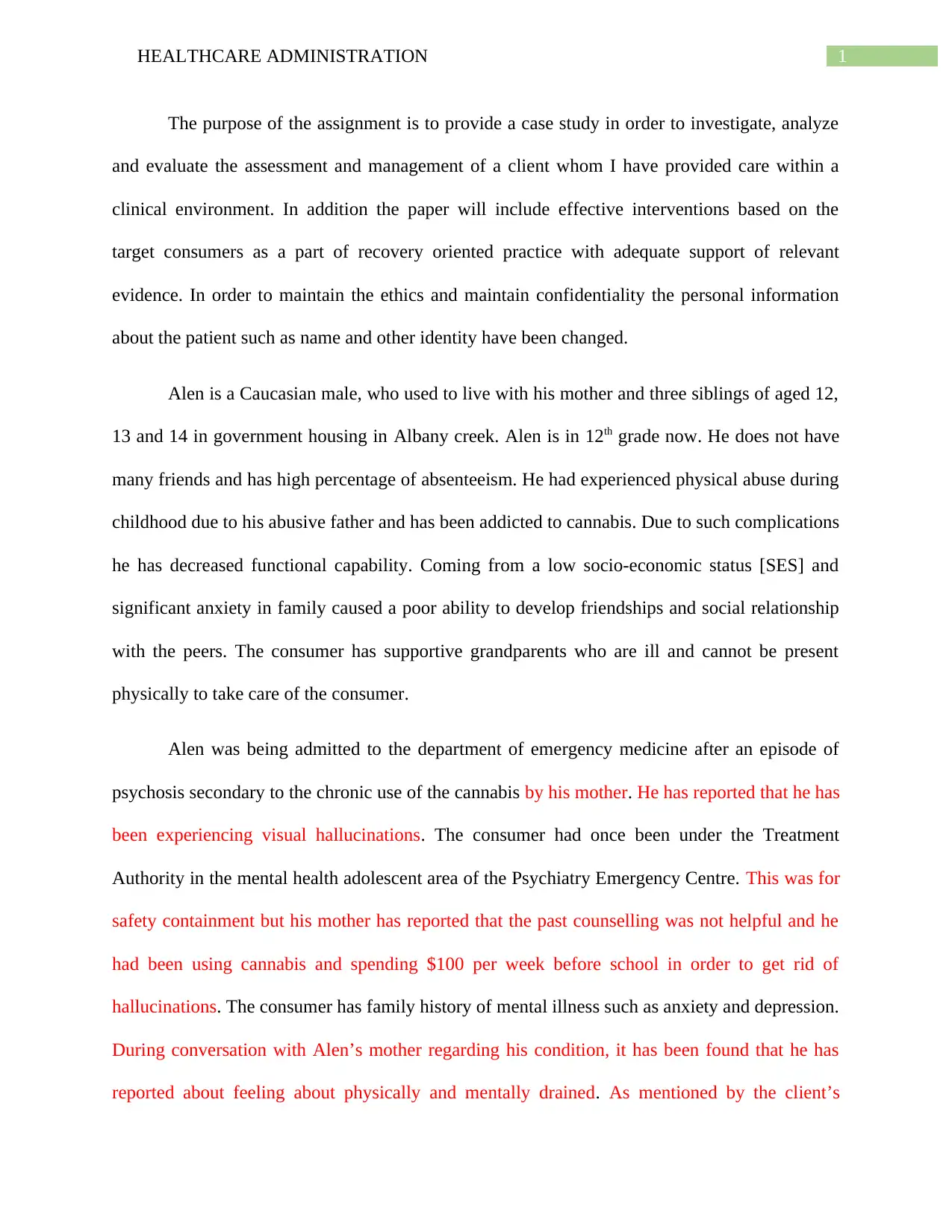
1HEALTHCARE ADMINISTRATION
The purpose of the assignment is to provide a case study in order to investigate, analyze
and evaluate the assessment and management of a client whom I have provided care within a
clinical environment. In addition the paper will include effective interventions based on the
target consumers as a part of recovery oriented practice with adequate support of relevant
evidence. In order to maintain the ethics and maintain confidentiality the personal information
about the patient such as name and other identity have been changed.
Alen is a Caucasian male, who used to live with his mother and three siblings of aged 12,
13 and 14 in government housing in Albany creek. Alen is in 12th grade now. He does not have
many friends and has high percentage of absenteeism. He had experienced physical abuse during
childhood due to his abusive father and has been addicted to cannabis. Due to such complications
he has decreased functional capability. Coming from a low socio-economic status [SES] and
significant anxiety in family caused a poor ability to develop friendships and social relationship
with the peers. The consumer has supportive grandparents who are ill and cannot be present
physically to take care of the consumer.
Alen was being admitted to the department of emergency medicine after an episode of
psychosis secondary to the chronic use of the cannabis by his mother. He has reported that he has
been experiencing visual hallucinations. The consumer had once been under the Treatment
Authority in the mental health adolescent area of the Psychiatry Emergency Centre. This was for
safety containment but his mother has reported that the past counselling was not helpful and he
had been using cannabis and spending $100 per week before school in order to get rid of
hallucinations. The consumer has family history of mental illness such as anxiety and depression.
During conversation with Alen’s mother regarding his condition, it has been found that he has
reported about feeling about physically and mentally drained. As mentioned by the client’s
The purpose of the assignment is to provide a case study in order to investigate, analyze
and evaluate the assessment and management of a client whom I have provided care within a
clinical environment. In addition the paper will include effective interventions based on the
target consumers as a part of recovery oriented practice with adequate support of relevant
evidence. In order to maintain the ethics and maintain confidentiality the personal information
about the patient such as name and other identity have been changed.
Alen is a Caucasian male, who used to live with his mother and three siblings of aged 12,
13 and 14 in government housing in Albany creek. Alen is in 12th grade now. He does not have
many friends and has high percentage of absenteeism. He had experienced physical abuse during
childhood due to his abusive father and has been addicted to cannabis. Due to such complications
he has decreased functional capability. Coming from a low socio-economic status [SES] and
significant anxiety in family caused a poor ability to develop friendships and social relationship
with the peers. The consumer has supportive grandparents who are ill and cannot be present
physically to take care of the consumer.
Alen was being admitted to the department of emergency medicine after an episode of
psychosis secondary to the chronic use of the cannabis by his mother. He has reported that he has
been experiencing visual hallucinations. The consumer had once been under the Treatment
Authority in the mental health adolescent area of the Psychiatry Emergency Centre. This was for
safety containment but his mother has reported that the past counselling was not helpful and he
had been using cannabis and spending $100 per week before school in order to get rid of
hallucinations. The consumer has family history of mental illness such as anxiety and depression.
During conversation with Alen’s mother regarding his condition, it has been found that he has
reported about feeling about physically and mentally drained. As mentioned by the client’s
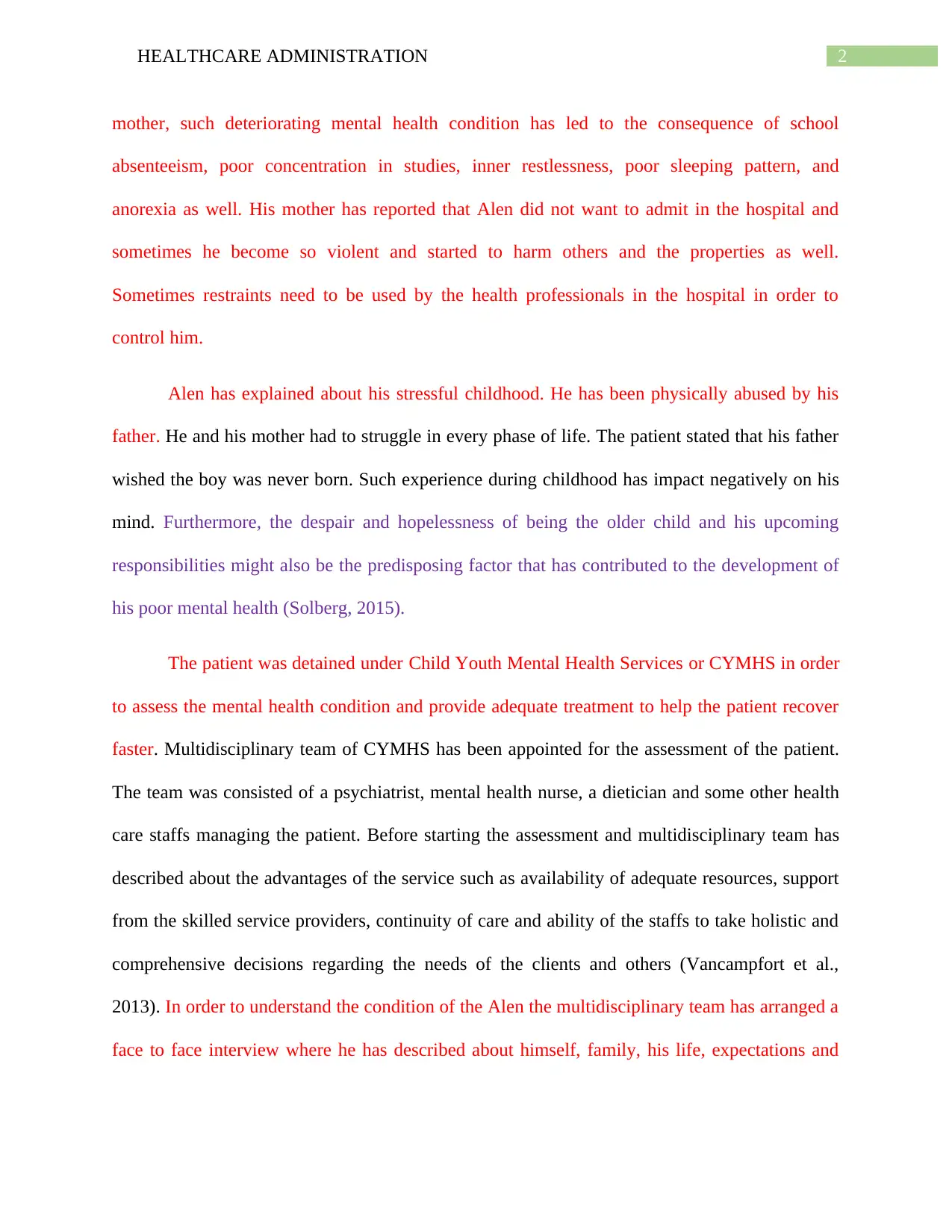
2HEALTHCARE ADMINISTRATION
mother, such deteriorating mental health condition has led to the consequence of school
absenteeism, poor concentration in studies, inner restlessness, poor sleeping pattern, and
anorexia as well. His mother has reported that Alen did not want to admit in the hospital and
sometimes he become so violent and started to harm others and the properties as well.
Sometimes restraints need to be used by the health professionals in the hospital in order to
control him.
Alen has explained about his stressful childhood. He has been physically abused by his
father. He and his mother had to struggle in every phase of life. The patient stated that his father
wished the boy was never born. Such experience during childhood has impact negatively on his
mind. Furthermore, the despair and hopelessness of being the older child and his upcoming
responsibilities might also be the predisposing factor that has contributed to the development of
his poor mental health (Solberg, 2015).
The patient was detained under Child Youth Mental Health Services or CYMHS in order
to assess the mental health condition and provide adequate treatment to help the patient recover
faster. Multidisciplinary team of CYMHS has been appointed for the assessment of the patient.
The team was consisted of a psychiatrist, mental health nurse, a dietician and some other health
care staffs managing the patient. Before starting the assessment and multidisciplinary team has
described about the advantages of the service such as availability of adequate resources, support
from the skilled service providers, continuity of care and ability of the staffs to take holistic and
comprehensive decisions regarding the needs of the clients and others (Vancampfort et al.,
2013). In order to understand the condition of the Alen the multidisciplinary team has arranged a
face to face interview where he has described about himself, family, his life, expectations and
mother, such deteriorating mental health condition has led to the consequence of school
absenteeism, poor concentration in studies, inner restlessness, poor sleeping pattern, and
anorexia as well. His mother has reported that Alen did not want to admit in the hospital and
sometimes he become so violent and started to harm others and the properties as well.
Sometimes restraints need to be used by the health professionals in the hospital in order to
control him.
Alen has explained about his stressful childhood. He has been physically abused by his
father. He and his mother had to struggle in every phase of life. The patient stated that his father
wished the boy was never born. Such experience during childhood has impact negatively on his
mind. Furthermore, the despair and hopelessness of being the older child and his upcoming
responsibilities might also be the predisposing factor that has contributed to the development of
his poor mental health (Solberg, 2015).
The patient was detained under Child Youth Mental Health Services or CYMHS in order
to assess the mental health condition and provide adequate treatment to help the patient recover
faster. Multidisciplinary team of CYMHS has been appointed for the assessment of the patient.
The team was consisted of a psychiatrist, mental health nurse, a dietician and some other health
care staffs managing the patient. Before starting the assessment and multidisciplinary team has
described about the advantages of the service such as availability of adequate resources, support
from the skilled service providers, continuity of care and ability of the staffs to take holistic and
comprehensive decisions regarding the needs of the clients and others (Vancampfort et al.,
2013). In order to understand the condition of the Alen the multidisciplinary team has arranged a
face to face interview where he has described about himself, family, his life, expectations and
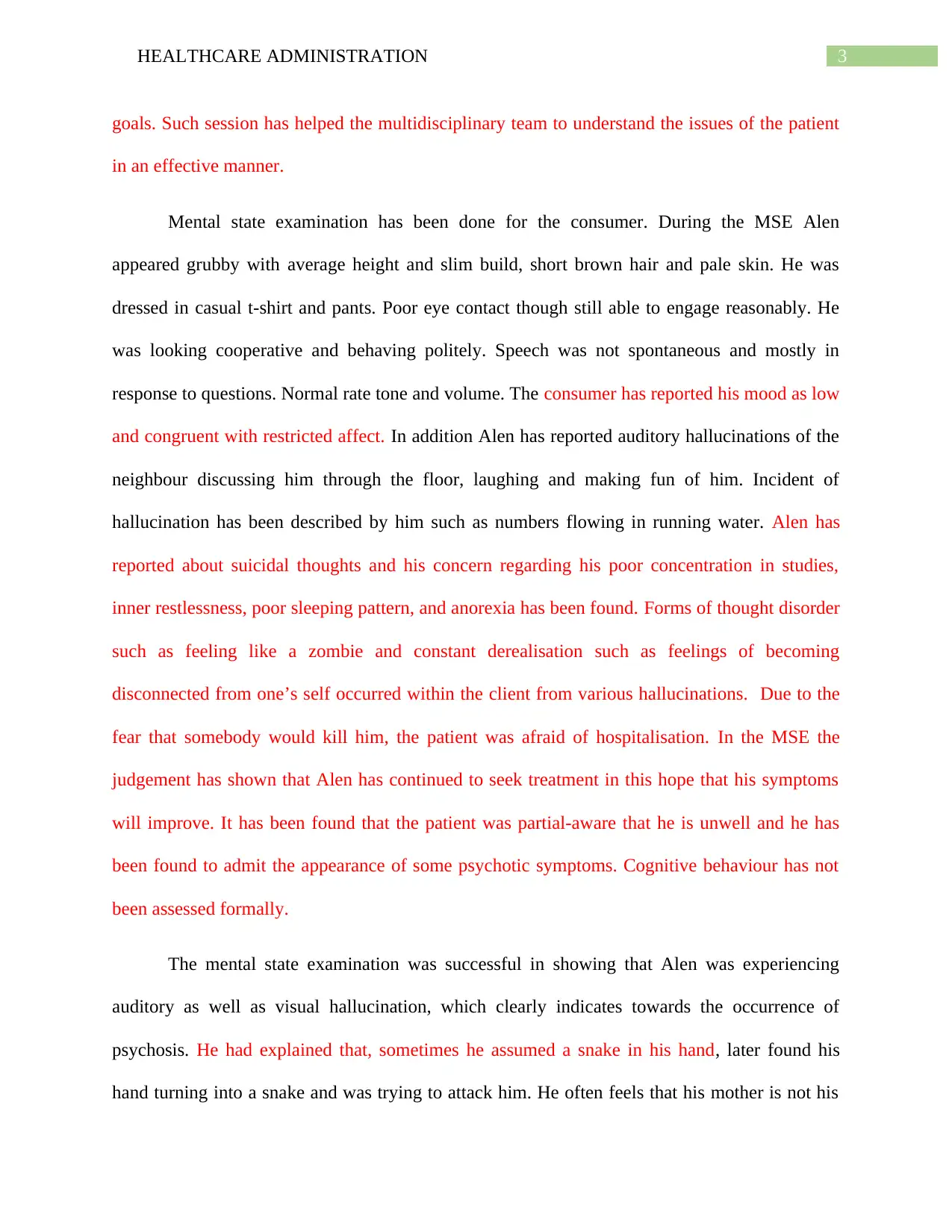
3HEALTHCARE ADMINISTRATION
goals. Such session has helped the multidisciplinary team to understand the issues of the patient
in an effective manner.
Mental state examination has been done for the consumer. During the MSE Alen
appeared grubby with average height and slim build, short brown hair and pale skin. He was
dressed in casual t-shirt and pants. Poor eye contact though still able to engage reasonably. He
was looking cooperative and behaving politely. Speech was not spontaneous and mostly in
response to questions. Normal rate tone and volume. The consumer has reported his mood as low
and congruent with restricted affect. In addition Alen has reported auditory hallucinations of the
neighbour discussing him through the floor, laughing and making fun of him. Incident of
hallucination has been described by him such as numbers flowing in running water. Alen has
reported about suicidal thoughts and his concern regarding his poor concentration in studies,
inner restlessness, poor sleeping pattern, and anorexia has been found. Forms of thought disorder
such as feeling like a zombie and constant derealisation such as feelings of becoming
disconnected from one’s self occurred within the client from various hallucinations. Due to the
fear that somebody would kill him, the patient was afraid of hospitalisation. In the MSE the
judgement has shown that Alen has continued to seek treatment in this hope that his symptoms
will improve. It has been found that the patient was partial-aware that he is unwell and he has
been found to admit the appearance of some psychotic symptoms. Cognitive behaviour has not
been assessed formally.
The mental state examination was successful in showing that Alen was experiencing
auditory as well as visual hallucination, which clearly indicates towards the occurrence of
psychosis. He had explained that, sometimes he assumed a snake in his hand, later found his
hand turning into a snake and was trying to attack him. He often feels that his mother is not his
goals. Such session has helped the multidisciplinary team to understand the issues of the patient
in an effective manner.
Mental state examination has been done for the consumer. During the MSE Alen
appeared grubby with average height and slim build, short brown hair and pale skin. He was
dressed in casual t-shirt and pants. Poor eye contact though still able to engage reasonably. He
was looking cooperative and behaving politely. Speech was not spontaneous and mostly in
response to questions. Normal rate tone and volume. The consumer has reported his mood as low
and congruent with restricted affect. In addition Alen has reported auditory hallucinations of the
neighbour discussing him through the floor, laughing and making fun of him. Incident of
hallucination has been described by him such as numbers flowing in running water. Alen has
reported about suicidal thoughts and his concern regarding his poor concentration in studies,
inner restlessness, poor sleeping pattern, and anorexia has been found. Forms of thought disorder
such as feeling like a zombie and constant derealisation such as feelings of becoming
disconnected from one’s self occurred within the client from various hallucinations. Due to the
fear that somebody would kill him, the patient was afraid of hospitalisation. In the MSE the
judgement has shown that Alen has continued to seek treatment in this hope that his symptoms
will improve. It has been found that the patient was partial-aware that he is unwell and he has
been found to admit the appearance of some psychotic symptoms. Cognitive behaviour has not
been assessed formally.
The mental state examination was successful in showing that Alen was experiencing
auditory as well as visual hallucination, which clearly indicates towards the occurrence of
psychosis. He had explained that, sometimes he assumed a snake in his hand, later found his
hand turning into a snake and was trying to attack him. He often feels that his mother is not his
Secure Best Marks with AI Grader
Need help grading? Try our AI Grader for instant feedback on your assignments.
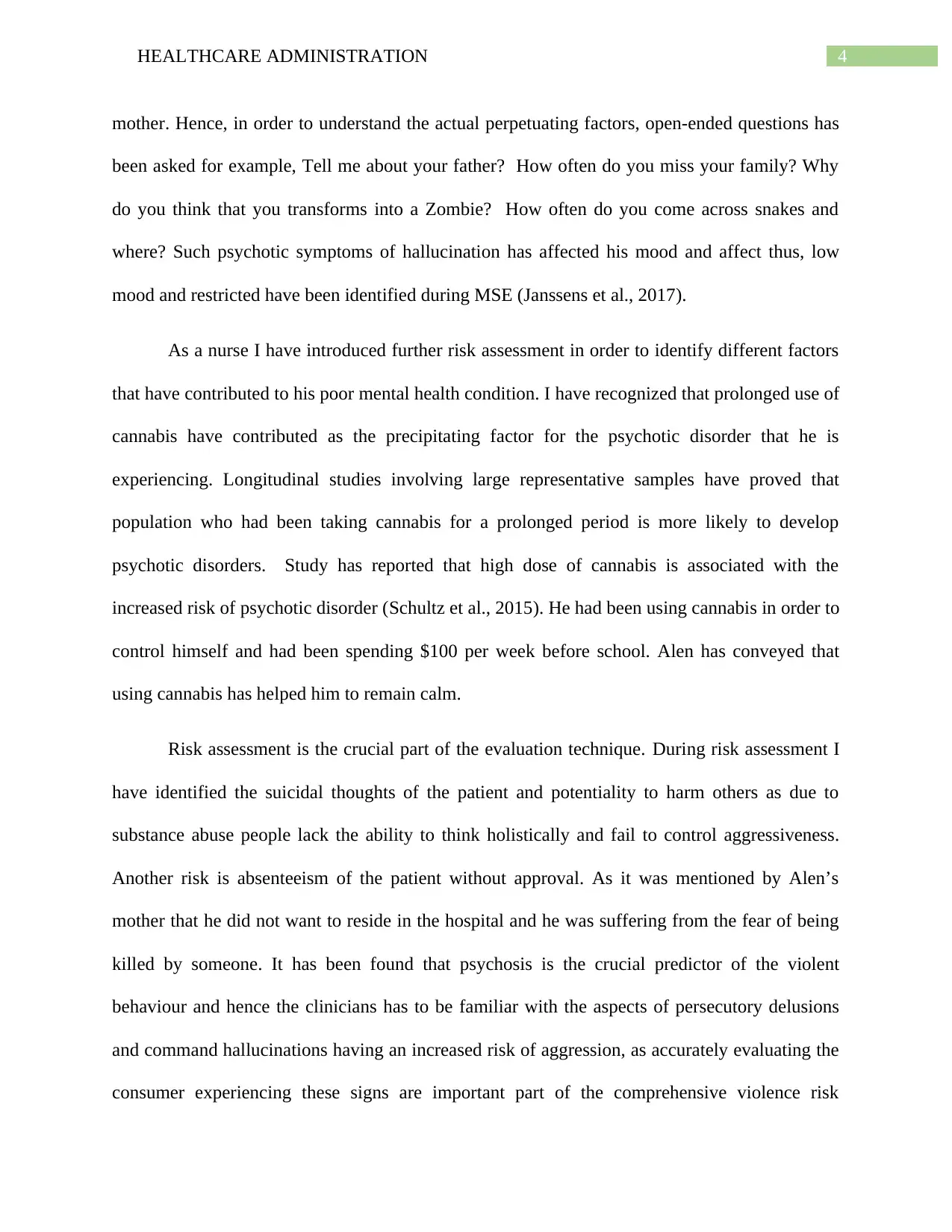
4HEALTHCARE ADMINISTRATION
mother. Hence, in order to understand the actual perpetuating factors, open-ended questions has
been asked for example, Tell me about your father? How often do you miss your family? Why
do you think that you transforms into a Zombie? How often do you come across snakes and
where? Such psychotic symptoms of hallucination has affected his mood and affect thus, low
mood and restricted have been identified during MSE (Janssens et al., 2017).
As a nurse I have introduced further risk assessment in order to identify different factors
that have contributed to his poor mental health condition. I have recognized that prolonged use of
cannabis have contributed as the precipitating factor for the psychotic disorder that he is
experiencing. Longitudinal studies involving large representative samples have proved that
population who had been taking cannabis for a prolonged period is more likely to develop
psychotic disorders. Study has reported that high dose of cannabis is associated with the
increased risk of psychotic disorder (Schultz et al., 2015). He had been using cannabis in order to
control himself and had been spending $100 per week before school. Alen has conveyed that
using cannabis has helped him to remain calm.
Risk assessment is the crucial part of the evaluation technique. During risk assessment I
have identified the suicidal thoughts of the patient and potentiality to harm others as due to
substance abuse people lack the ability to think holistically and fail to control aggressiveness.
Another risk is absenteeism of the patient without approval. As it was mentioned by Alen’s
mother that he did not want to reside in the hospital and he was suffering from the fear of being
killed by someone. It has been found that psychosis is the crucial predictor of the violent
behaviour and hence the clinicians has to be familiar with the aspects of persecutory delusions
and command hallucinations having an increased risk of aggression, as accurately evaluating the
consumer experiencing these signs are important part of the comprehensive violence risk
mother. Hence, in order to understand the actual perpetuating factors, open-ended questions has
been asked for example, Tell me about your father? How often do you miss your family? Why
do you think that you transforms into a Zombie? How often do you come across snakes and
where? Such psychotic symptoms of hallucination has affected his mood and affect thus, low
mood and restricted have been identified during MSE (Janssens et al., 2017).
As a nurse I have introduced further risk assessment in order to identify different factors
that have contributed to his poor mental health condition. I have recognized that prolonged use of
cannabis have contributed as the precipitating factor for the psychotic disorder that he is
experiencing. Longitudinal studies involving large representative samples have proved that
population who had been taking cannabis for a prolonged period is more likely to develop
psychotic disorders. Study has reported that high dose of cannabis is associated with the
increased risk of psychotic disorder (Schultz et al., 2015). He had been using cannabis in order to
control himself and had been spending $100 per week before school. Alen has conveyed that
using cannabis has helped him to remain calm.
Risk assessment is the crucial part of the evaluation technique. During risk assessment I
have identified the suicidal thoughts of the patient and potentiality to harm others as due to
substance abuse people lack the ability to think holistically and fail to control aggressiveness.
Another risk is absenteeism of the patient without approval. As it was mentioned by Alen’s
mother that he did not want to reside in the hospital and he was suffering from the fear of being
killed by someone. It has been found that psychosis is the crucial predictor of the violent
behaviour and hence the clinicians has to be familiar with the aspects of persecutory delusions
and command hallucinations having an increased risk of aggression, as accurately evaluating the
consumer experiencing these signs are important part of the comprehensive violence risk

5HEALTHCARE ADMINISTRATION
assessment (Waters et al., 2014). Beside such mental issues several physical health issues are
also identified such as poor sleeping pattern and loss of appetite. Being a nurse, I tried to engage
in therapeutic conversation with the patient explaining him that thoughts of suicide and
absconding would not help him to get treated but would certainly get him away from his mother.
I have asked repeated questions in order to identify the reasons for his suicidal thoughts. The
childhood trauma, due to his abusive father is another identified risk regarding his psychotic
symptoms (Mizrahi, 2016). The treatment plan that has been made later on has been planned,
keeping these risks on mind. Such identification of risk factor is important as avoiding such risk
factors during treatment could trigger psychotic symptoms and lead to violation in the later life
as post-traumatic stress disorder through nightmares, flashbacks and some uncontrollable
thoughts regarding the past incidents (Yehuda et al., 2015).
One of the factors of obstruction in the building up of a therapeutic relationship with the
consumer is lack of engagement with the client. When I first met the patient he was nervous as
he was a paranoid, thus, he was facing some problems to trust me (Kaufman et al., 2012).
Different demographic factors have restricted me to communicate with the consumer. For
example, I was elder that the consumer thus, the gap of age and thinking has contributed to the
difficulties in communication (Norouzinia et al., 2016). In addition we were from different
cultural background, thus the cultural views and ethnicity have played an important role in
creating barriers in therapeutic relationship (Taylor, Nicolle & Maguire, 2013). Furthermore, the
power imbalance between me and the consumer has created nervousness within the patient
which has restricted the patient to communicate with me freely (Norouzinia et al., 2016).
However, I have tried to use my communication skills and started to communicate with general
interaction such as greetings. I have described about myself, my name, role in his treatment and
assessment (Waters et al., 2014). Beside such mental issues several physical health issues are
also identified such as poor sleeping pattern and loss of appetite. Being a nurse, I tried to engage
in therapeutic conversation with the patient explaining him that thoughts of suicide and
absconding would not help him to get treated but would certainly get him away from his mother.
I have asked repeated questions in order to identify the reasons for his suicidal thoughts. The
childhood trauma, due to his abusive father is another identified risk regarding his psychotic
symptoms (Mizrahi, 2016). The treatment plan that has been made later on has been planned,
keeping these risks on mind. Such identification of risk factor is important as avoiding such risk
factors during treatment could trigger psychotic symptoms and lead to violation in the later life
as post-traumatic stress disorder through nightmares, flashbacks and some uncontrollable
thoughts regarding the past incidents (Yehuda et al., 2015).
One of the factors of obstruction in the building up of a therapeutic relationship with the
consumer is lack of engagement with the client. When I first met the patient he was nervous as
he was a paranoid, thus, he was facing some problems to trust me (Kaufman et al., 2012).
Different demographic factors have restricted me to communicate with the consumer. For
example, I was elder that the consumer thus, the gap of age and thinking has contributed to the
difficulties in communication (Norouzinia et al., 2016). In addition we were from different
cultural background, thus the cultural views and ethnicity have played an important role in
creating barriers in therapeutic relationship (Taylor, Nicolle & Maguire, 2013). Furthermore, the
power imbalance between me and the consumer has created nervousness within the patient
which has restricted the patient to communicate with me freely (Norouzinia et al., 2016).
However, I have tried to use my communication skills and started to communicate with general
interaction such as greetings. I have described about myself, my name, role in his treatment and
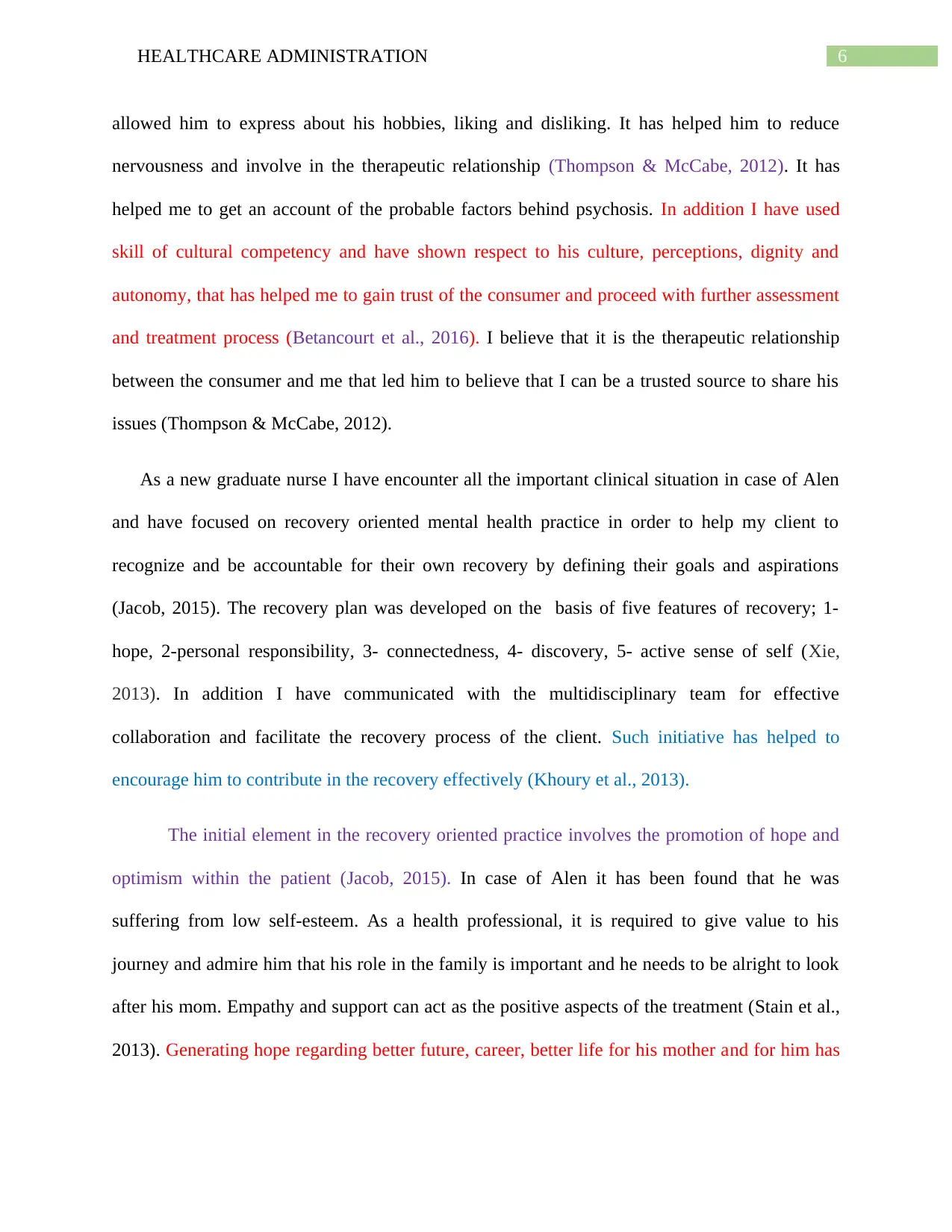
6HEALTHCARE ADMINISTRATION
allowed him to express about his hobbies, liking and disliking. It has helped him to reduce
nervousness and involve in the therapeutic relationship (Thompson & McCabe, 2012). It has
helped me to get an account of the probable factors behind psychosis. In addition I have used
skill of cultural competency and have shown respect to his culture, perceptions, dignity and
autonomy, that has helped me to gain trust of the consumer and proceed with further assessment
and treatment process (Betancourt et al., 2016). I believe that it is the therapeutic relationship
between the consumer and me that led him to believe that I can be a trusted source to share his
issues (Thompson & McCabe, 2012).
As a new graduate nurse I have encounter all the important clinical situation in case of Alen
and have focused on recovery oriented mental health practice in order to help my client to
recognize and be accountable for their own recovery by defining their goals and aspirations
(Jacob, 2015). The recovery plan was developed on the basis of five features of recovery; 1-
hope, 2-personal responsibility, 3- connectedness, 4- discovery, 5- active sense of self (Xie,
2013). In addition I have communicated with the multidisciplinary team for effective
collaboration and facilitate the recovery process of the client. Such initiative has helped to
encourage him to contribute in the recovery effectively (Khoury et al., 2013).
The initial element in the recovery oriented practice involves the promotion of hope and
optimism within the patient (Jacob, 2015). In case of Alen it has been found that he was
suffering from low self-esteem. As a health professional, it is required to give value to his
journey and admire him that his role in the family is important and he needs to be alright to look
after his mom. Empathy and support can act as the positive aspects of the treatment (Stain et al.,
2013). Generating hope regarding better future, career, better life for his mother and for him has
allowed him to express about his hobbies, liking and disliking. It has helped him to reduce
nervousness and involve in the therapeutic relationship (Thompson & McCabe, 2012). It has
helped me to get an account of the probable factors behind psychosis. In addition I have used
skill of cultural competency and have shown respect to his culture, perceptions, dignity and
autonomy, that has helped me to gain trust of the consumer and proceed with further assessment
and treatment process (Betancourt et al., 2016). I believe that it is the therapeutic relationship
between the consumer and me that led him to believe that I can be a trusted source to share his
issues (Thompson & McCabe, 2012).
As a new graduate nurse I have encounter all the important clinical situation in case of Alen
and have focused on recovery oriented mental health practice in order to help my client to
recognize and be accountable for their own recovery by defining their goals and aspirations
(Jacob, 2015). The recovery plan was developed on the basis of five features of recovery; 1-
hope, 2-personal responsibility, 3- connectedness, 4- discovery, 5- active sense of self (Xie,
2013). In addition I have communicated with the multidisciplinary team for effective
collaboration and facilitate the recovery process of the client. Such initiative has helped to
encourage him to contribute in the recovery effectively (Khoury et al., 2013).
The initial element in the recovery oriented practice involves the promotion of hope and
optimism within the patient (Jacob, 2015). In case of Alen it has been found that he was
suffering from low self-esteem. As a health professional, it is required to give value to his
journey and admire him that his role in the family is important and he needs to be alright to look
after his mom. Empathy and support can act as the positive aspects of the treatment (Stain et al.,
2013). Generating hope regarding better future, career, better life for his mother and for him has
Paraphrase This Document
Need a fresh take? Get an instant paraphrase of this document with our AI Paraphraser
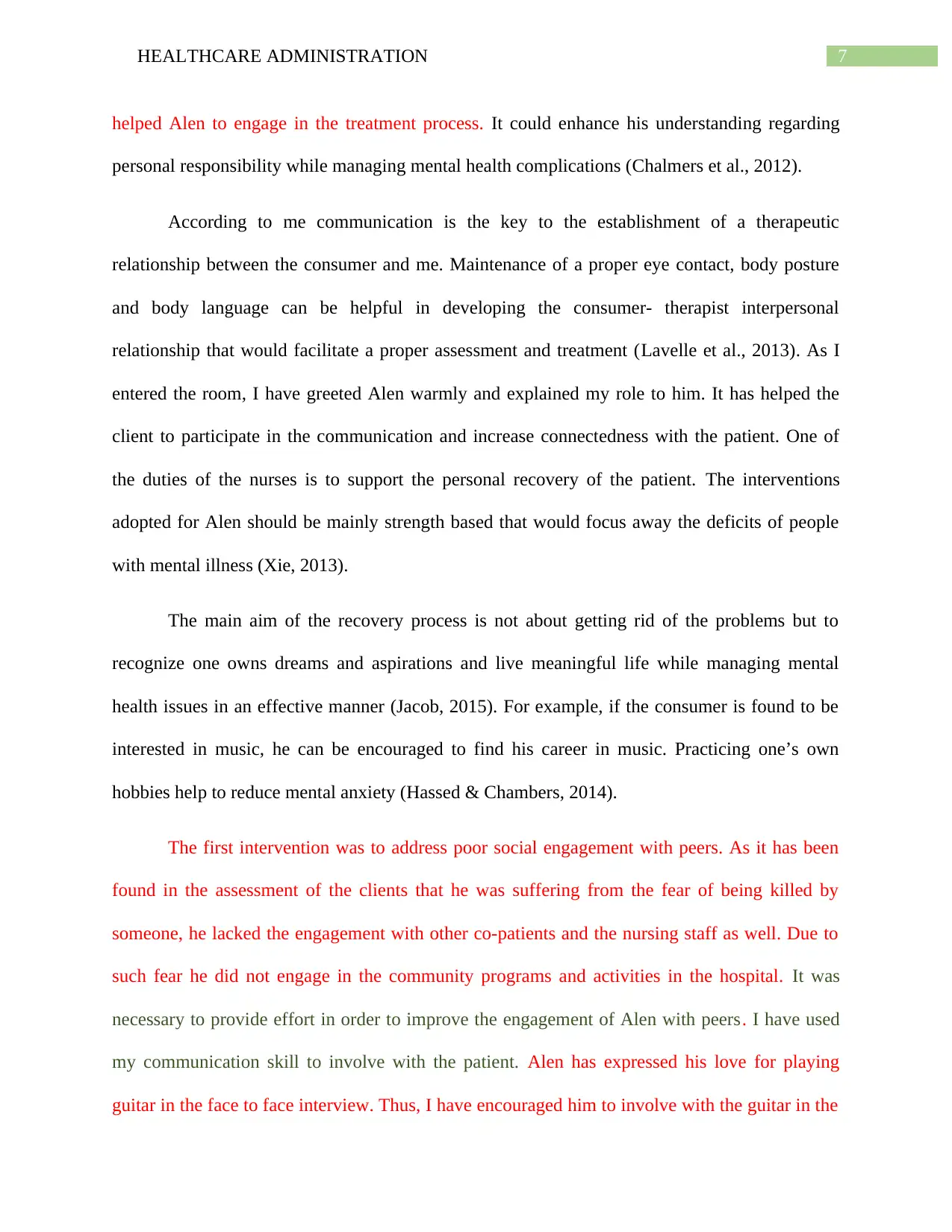
7HEALTHCARE ADMINISTRATION
helped Alen to engage in the treatment process. It could enhance his understanding regarding
personal responsibility while managing mental health complications (Chalmers et al., 2012).
According to me communication is the key to the establishment of a therapeutic
relationship between the consumer and me. Maintenance of a proper eye contact, body posture
and body language can be helpful in developing the consumer- therapist interpersonal
relationship that would facilitate a proper assessment and treatment (Lavelle et al., 2013). As I
entered the room, I have greeted Alen warmly and explained my role to him. It has helped the
client to participate in the communication and increase connectedness with the patient. One of
the duties of the nurses is to support the personal recovery of the patient. The interventions
adopted for Alen should be mainly strength based that would focus away the deficits of people
with mental illness (Xie, 2013).
The main aim of the recovery process is not about getting rid of the problems but to
recognize one owns dreams and aspirations and live meaningful life while managing mental
health issues in an effective manner (Jacob, 2015). For example, if the consumer is found to be
interested in music, he can be encouraged to find his career in music. Practicing one’s own
hobbies help to reduce mental anxiety (Hassed & Chambers, 2014).
The first intervention was to address poor social engagement with peers. As it has been
found in the assessment of the clients that he was suffering from the fear of being killed by
someone, he lacked the engagement with other co-patients and the nursing staff as well. Due to
such fear he did not engage in the community programs and activities in the hospital. It was
necessary to provide effort in order to improve the engagement of Alen with peers. I have used
my communication skill to involve with the patient. Alen has expressed his love for playing
guitar in the face to face interview. Thus, I have encouraged him to involve with the guitar in the
helped Alen to engage in the treatment process. It could enhance his understanding regarding
personal responsibility while managing mental health complications (Chalmers et al., 2012).
According to me communication is the key to the establishment of a therapeutic
relationship between the consumer and me. Maintenance of a proper eye contact, body posture
and body language can be helpful in developing the consumer- therapist interpersonal
relationship that would facilitate a proper assessment and treatment (Lavelle et al., 2013). As I
entered the room, I have greeted Alen warmly and explained my role to him. It has helped the
client to participate in the communication and increase connectedness with the patient. One of
the duties of the nurses is to support the personal recovery of the patient. The interventions
adopted for Alen should be mainly strength based that would focus away the deficits of people
with mental illness (Xie, 2013).
The main aim of the recovery process is not about getting rid of the problems but to
recognize one owns dreams and aspirations and live meaningful life while managing mental
health issues in an effective manner (Jacob, 2015). For example, if the consumer is found to be
interested in music, he can be encouraged to find his career in music. Practicing one’s own
hobbies help to reduce mental anxiety (Hassed & Chambers, 2014).
The first intervention was to address poor social engagement with peers. As it has been
found in the assessment of the clients that he was suffering from the fear of being killed by
someone, he lacked the engagement with other co-patients and the nursing staff as well. Due to
such fear he did not engage in the community programs and activities in the hospital. It was
necessary to provide effort in order to improve the engagement of Alen with peers. I have used
my communication skill to involve with the patient. Alen has expressed his love for playing
guitar in the face to face interview. Thus, I have encouraged him to involve with the guitar in the

8HEALTHCARE ADMINISTRATION
hospital. Other co-patients and nursing staffs have praised him for his talent of playing guitar.
Gradually he has started to trust people and started to communicate with them. Furthermore, he
has shown his interest in tourism, thus, I have given him some tourism related books and
magazine to read and share his experience with other patients (Koh et al., 2013). Such strategies
have helped him to recover from the fear of being killed by someone and he has improved his
engagement with the peers (Carman et al., 2013). He has been found to participate in different
activities in the hospital and community programs. Such interventions have helped him to
increase community level participation and enhance connectedness in an effective manner (Koh
et al., 2013).
The second intervention was to reduce anxiety. In order to improve the sensory
perception it is important to introduce anxiety management and to improve the connectedness
with the outside world. I have helped the patient to manage his anxiety via providing him
different anxiety management approaches. Anxiety management has helped in the generation of
connectedness and generate active sense of self by reducing negative thinking and stress
(Ratanasiripong et al., 2015). According to Thomson et al. (2017) proper anxiety management
has helped to reduce the audio-visual hallucinations and thereby reducing the level of psychosis
or delusional thinking. I have used basic techniques such as physical exercise and yoga to help
him to concentrate in the treatment and reduce stress. I have prepared a schedule for proper diet
and sleep. I have provided relaxation techniques like listening to music at night, techniques for
tame tense muscles and taking deep breath to reduce his stress level and avoid the panic
moments (Ratanasiripong et al., 2015). This has involved Alen self-regulation of attention and
non-judgmental awareness of present moment experience like sensations, bodily states and
thoughts. The symptoms of psychosis such as hearing unpleasant sounds and visualise things that
hospital. Other co-patients and nursing staffs have praised him for his talent of playing guitar.
Gradually he has started to trust people and started to communicate with them. Furthermore, he
has shown his interest in tourism, thus, I have given him some tourism related books and
magazine to read and share his experience with other patients (Koh et al., 2013). Such strategies
have helped him to recover from the fear of being killed by someone and he has improved his
engagement with the peers (Carman et al., 2013). He has been found to participate in different
activities in the hospital and community programs. Such interventions have helped him to
increase community level participation and enhance connectedness in an effective manner (Koh
et al., 2013).
The second intervention was to reduce anxiety. In order to improve the sensory
perception it is important to introduce anxiety management and to improve the connectedness
with the outside world. I have helped the patient to manage his anxiety via providing him
different anxiety management approaches. Anxiety management has helped in the generation of
connectedness and generate active sense of self by reducing negative thinking and stress
(Ratanasiripong et al., 2015). According to Thomson et al. (2017) proper anxiety management
has helped to reduce the audio-visual hallucinations and thereby reducing the level of psychosis
or delusional thinking. I have used basic techniques such as physical exercise and yoga to help
him to concentrate in the treatment and reduce stress. I have prepared a schedule for proper diet
and sleep. I have provided relaxation techniques like listening to music at night, techniques for
tame tense muscles and taking deep breath to reduce his stress level and avoid the panic
moments (Ratanasiripong et al., 2015). This has involved Alen self-regulation of attention and
non-judgmental awareness of present moment experience like sensations, bodily states and
thoughts. The symptoms of psychosis such as hearing unpleasant sounds and visualise things that
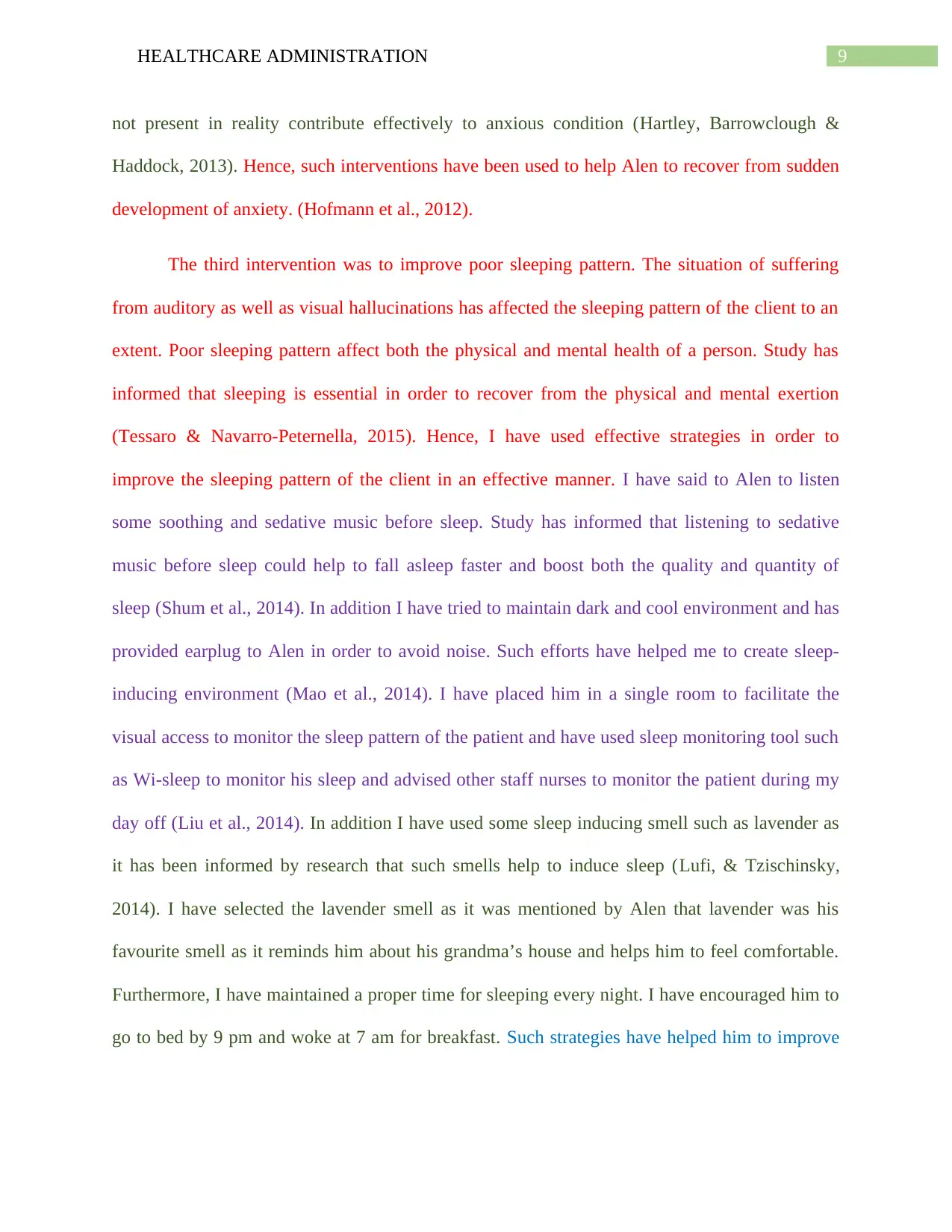
9HEALTHCARE ADMINISTRATION
not present in reality contribute effectively to anxious condition (Hartley, Barrowclough &
Haddock, 2013). Hence, such interventions have been used to help Alen to recover from sudden
development of anxiety. (Hofmann et al., 2012).
The third intervention was to improve poor sleeping pattern. The situation of suffering
from auditory as well as visual hallucinations has affected the sleeping pattern of the client to an
extent. Poor sleeping pattern affect both the physical and mental health of a person. Study has
informed that sleeping is essential in order to recover from the physical and mental exertion
(Tessaro & Navarro-Peternella, 2015). Hence, I have used effective strategies in order to
improve the sleeping pattern of the client in an effective manner. I have said to Alen to listen
some soothing and sedative music before sleep. Study has informed that listening to sedative
music before sleep could help to fall asleep faster and boost both the quality and quantity of
sleep (Shum et al., 2014). In addition I have tried to maintain dark and cool environment and has
provided earplug to Alen in order to avoid noise. Such efforts have helped me to create sleep-
inducing environment (Mao et al., 2014). I have placed him in a single room to facilitate the
visual access to monitor the sleep pattern of the patient and have used sleep monitoring tool such
as Wi-sleep to monitor his sleep and advised other staff nurses to monitor the patient during my
day off (Liu et al., 2014). In addition I have used some sleep inducing smell such as lavender as
it has been informed by research that such smells help to induce sleep (Lufi, & Tzischinsky,
2014). I have selected the lavender smell as it was mentioned by Alen that lavender was his
favourite smell as it reminds him about his grandma’s house and helps him to feel comfortable.
Furthermore, I have maintained a proper time for sleeping every night. I have encouraged him to
go to bed by 9 pm and woke at 7 am for breakfast. Such strategies have helped him to improve
not present in reality contribute effectively to anxious condition (Hartley, Barrowclough &
Haddock, 2013). Hence, such interventions have been used to help Alen to recover from sudden
development of anxiety. (Hofmann et al., 2012).
The third intervention was to improve poor sleeping pattern. The situation of suffering
from auditory as well as visual hallucinations has affected the sleeping pattern of the client to an
extent. Poor sleeping pattern affect both the physical and mental health of a person. Study has
informed that sleeping is essential in order to recover from the physical and mental exertion
(Tessaro & Navarro-Peternella, 2015). Hence, I have used effective strategies in order to
improve the sleeping pattern of the client in an effective manner. I have said to Alen to listen
some soothing and sedative music before sleep. Study has informed that listening to sedative
music before sleep could help to fall asleep faster and boost both the quality and quantity of
sleep (Shum et al., 2014). In addition I have tried to maintain dark and cool environment and has
provided earplug to Alen in order to avoid noise. Such efforts have helped me to create sleep-
inducing environment (Mao et al., 2014). I have placed him in a single room to facilitate the
visual access to monitor the sleep pattern of the patient and have used sleep monitoring tool such
as Wi-sleep to monitor his sleep and advised other staff nurses to monitor the patient during my
day off (Liu et al., 2014). In addition I have used some sleep inducing smell such as lavender as
it has been informed by research that such smells help to induce sleep (Lufi, & Tzischinsky,
2014). I have selected the lavender smell as it was mentioned by Alen that lavender was his
favourite smell as it reminds him about his grandma’s house and helps him to feel comfortable.
Furthermore, I have maintained a proper time for sleeping every night. I have encouraged him to
go to bed by 9 pm and woke at 7 am for breakfast. Such strategies have helped him to improve
Secure Best Marks with AI Grader
Need help grading? Try our AI Grader for instant feedback on your assignments.
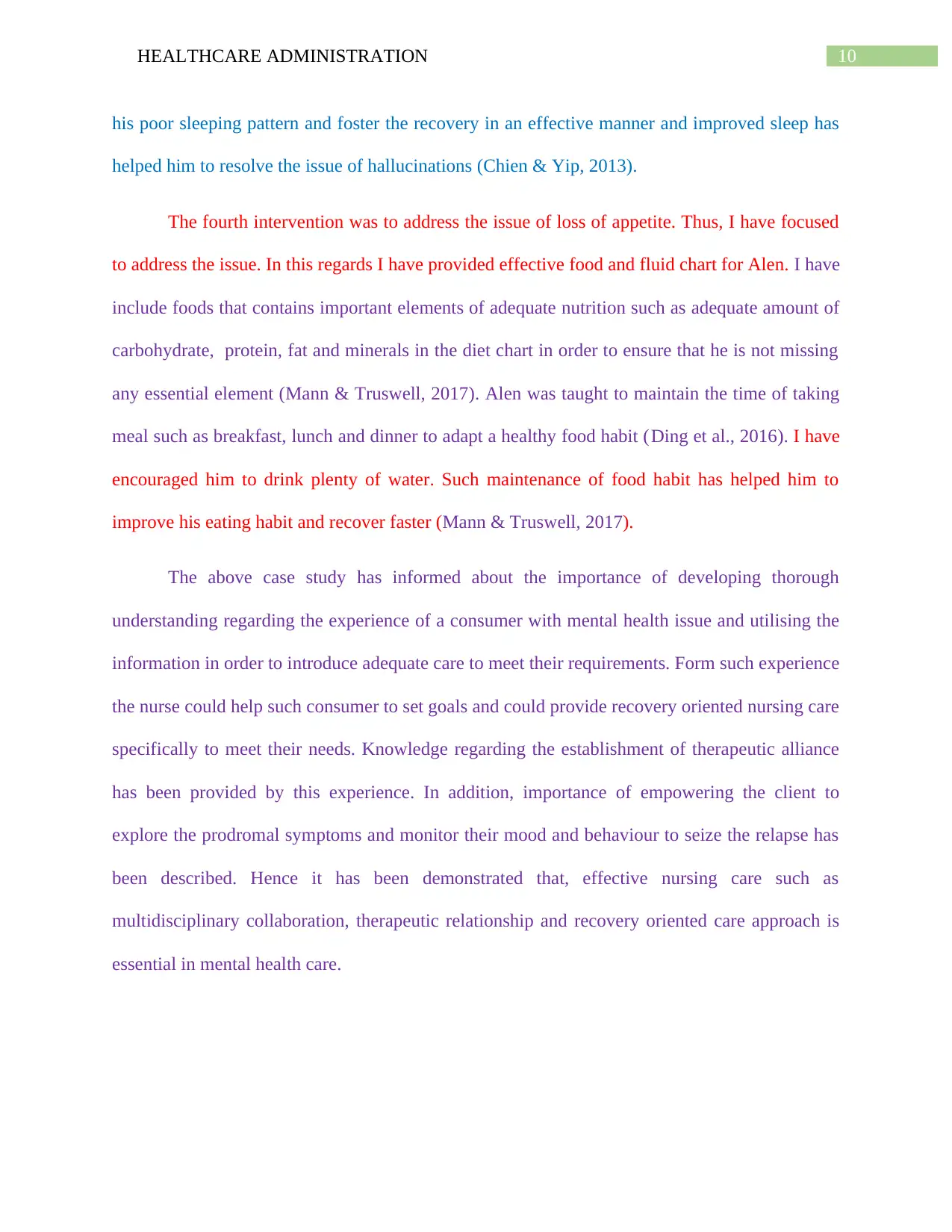
10HEALTHCARE ADMINISTRATION
his poor sleeping pattern and foster the recovery in an effective manner and improved sleep has
helped him to resolve the issue of hallucinations (Chien & Yip, 2013).
The fourth intervention was to address the issue of loss of appetite. Thus, I have focused
to address the issue. In this regards I have provided effective food and fluid chart for Alen. I have
include foods that contains important elements of adequate nutrition such as adequate amount of
carbohydrate, protein, fat and minerals in the diet chart in order to ensure that he is not missing
any essential element (Mann & Truswell, 2017). Alen was taught to maintain the time of taking
meal such as breakfast, lunch and dinner to adapt a healthy food habit (Ding et al., 2016). I have
encouraged him to drink plenty of water. Such maintenance of food habit has helped him to
improve his eating habit and recover faster (Mann & Truswell, 2017).
The above case study has informed about the importance of developing thorough
understanding regarding the experience of a consumer with mental health issue and utilising the
information in order to introduce adequate care to meet their requirements. Form such experience
the nurse could help such consumer to set goals and could provide recovery oriented nursing care
specifically to meet their needs. Knowledge regarding the establishment of therapeutic alliance
has been provided by this experience. In addition, importance of empowering the client to
explore the prodromal symptoms and monitor their mood and behaviour to seize the relapse has
been described. Hence it has been demonstrated that, effective nursing care such as
multidisciplinary collaboration, therapeutic relationship and recovery oriented care approach is
essential in mental health care.
his poor sleeping pattern and foster the recovery in an effective manner and improved sleep has
helped him to resolve the issue of hallucinations (Chien & Yip, 2013).
The fourth intervention was to address the issue of loss of appetite. Thus, I have focused
to address the issue. In this regards I have provided effective food and fluid chart for Alen. I have
include foods that contains important elements of adequate nutrition such as adequate amount of
carbohydrate, protein, fat and minerals in the diet chart in order to ensure that he is not missing
any essential element (Mann & Truswell, 2017). Alen was taught to maintain the time of taking
meal such as breakfast, lunch and dinner to adapt a healthy food habit (Ding et al., 2016). I have
encouraged him to drink plenty of water. Such maintenance of food habit has helped him to
improve his eating habit and recover faster (Mann & Truswell, 2017).
The above case study has informed about the importance of developing thorough
understanding regarding the experience of a consumer with mental health issue and utilising the
information in order to introduce adequate care to meet their requirements. Form such experience
the nurse could help such consumer to set goals and could provide recovery oriented nursing care
specifically to meet their needs. Knowledge regarding the establishment of therapeutic alliance
has been provided by this experience. In addition, importance of empowering the client to
explore the prodromal symptoms and monitor their mood and behaviour to seize the relapse has
been described. Hence it has been demonstrated that, effective nursing care such as
multidisciplinary collaboration, therapeutic relationship and recovery oriented care approach is
essential in mental health care.
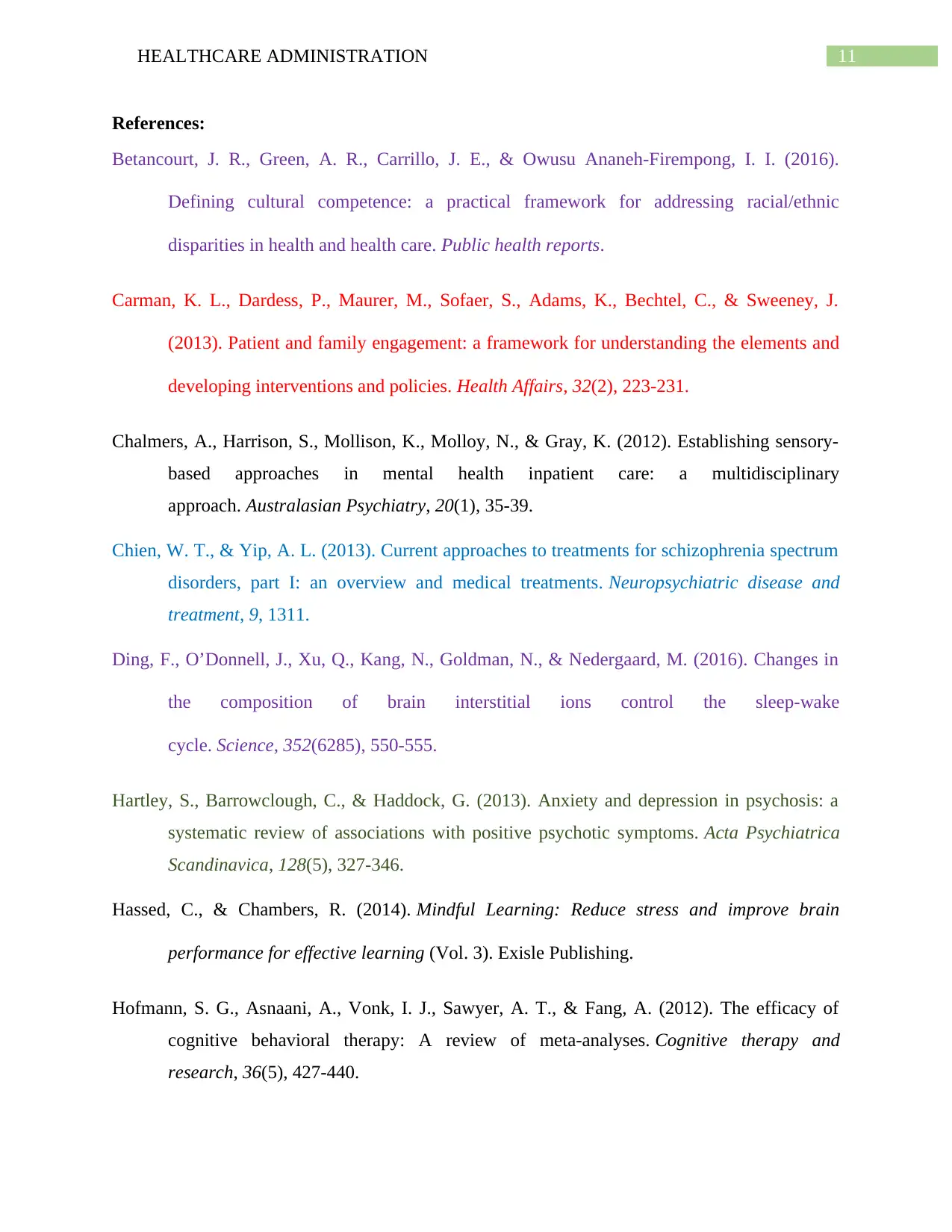
11HEALTHCARE ADMINISTRATION
References:
Betancourt, J. R., Green, A. R., Carrillo, J. E., & Owusu Ananeh-Firempong, I. I. (2016).
Defining cultural competence: a practical framework for addressing racial/ethnic
disparities in health and health care. Public health reports.
Carman, K. L., Dardess, P., Maurer, M., Sofaer, S., Adams, K., Bechtel, C., & Sweeney, J.
(2013). Patient and family engagement: a framework for understanding the elements and
developing interventions and policies. Health Affairs, 32(2), 223-231.
Chalmers, A., Harrison, S., Mollison, K., Molloy, N., & Gray, K. (2012). Establishing sensory-
based approaches in mental health inpatient care: a multidisciplinary
approach. Australasian Psychiatry, 20(1), 35-39.
Chien, W. T., & Yip, A. L. (2013). Current approaches to treatments for schizophrenia spectrum
disorders, part I: an overview and medical treatments. Neuropsychiatric disease and
treatment, 9, 1311.
Ding, F., O’Donnell, J., Xu, Q., Kang, N., Goldman, N., & Nedergaard, M. (2016). Changes in
the composition of brain interstitial ions control the sleep-wake
cycle. Science, 352(6285), 550-555.
Hartley, S., Barrowclough, C., & Haddock, G. (2013). Anxiety and depression in psychosis: a
systematic review of associations with positive psychotic symptoms. Acta Psychiatrica
Scandinavica, 128(5), 327-346.
Hassed, C., & Chambers, R. (2014). Mindful Learning: Reduce stress and improve brain
performance for effective learning (Vol. 3). Exisle Publishing.
Hofmann, S. G., Asnaani, A., Vonk, I. J., Sawyer, A. T., & Fang, A. (2012). The efficacy of
cognitive behavioral therapy: A review of meta-analyses. Cognitive therapy and
research, 36(5), 427-440.
References:
Betancourt, J. R., Green, A. R., Carrillo, J. E., & Owusu Ananeh-Firempong, I. I. (2016).
Defining cultural competence: a practical framework for addressing racial/ethnic
disparities in health and health care. Public health reports.
Carman, K. L., Dardess, P., Maurer, M., Sofaer, S., Adams, K., Bechtel, C., & Sweeney, J.
(2013). Patient and family engagement: a framework for understanding the elements and
developing interventions and policies. Health Affairs, 32(2), 223-231.
Chalmers, A., Harrison, S., Mollison, K., Molloy, N., & Gray, K. (2012). Establishing sensory-
based approaches in mental health inpatient care: a multidisciplinary
approach. Australasian Psychiatry, 20(1), 35-39.
Chien, W. T., & Yip, A. L. (2013). Current approaches to treatments for schizophrenia spectrum
disorders, part I: an overview and medical treatments. Neuropsychiatric disease and
treatment, 9, 1311.
Ding, F., O’Donnell, J., Xu, Q., Kang, N., Goldman, N., & Nedergaard, M. (2016). Changes in
the composition of brain interstitial ions control the sleep-wake
cycle. Science, 352(6285), 550-555.
Hartley, S., Barrowclough, C., & Haddock, G. (2013). Anxiety and depression in psychosis: a
systematic review of associations with positive psychotic symptoms. Acta Psychiatrica
Scandinavica, 128(5), 327-346.
Hassed, C., & Chambers, R. (2014). Mindful Learning: Reduce stress and improve brain
performance for effective learning (Vol. 3). Exisle Publishing.
Hofmann, S. G., Asnaani, A., Vonk, I. J., Sawyer, A. T., & Fang, A. (2012). The efficacy of
cognitive behavioral therapy: A review of meta-analyses. Cognitive therapy and
research, 36(5), 427-440.
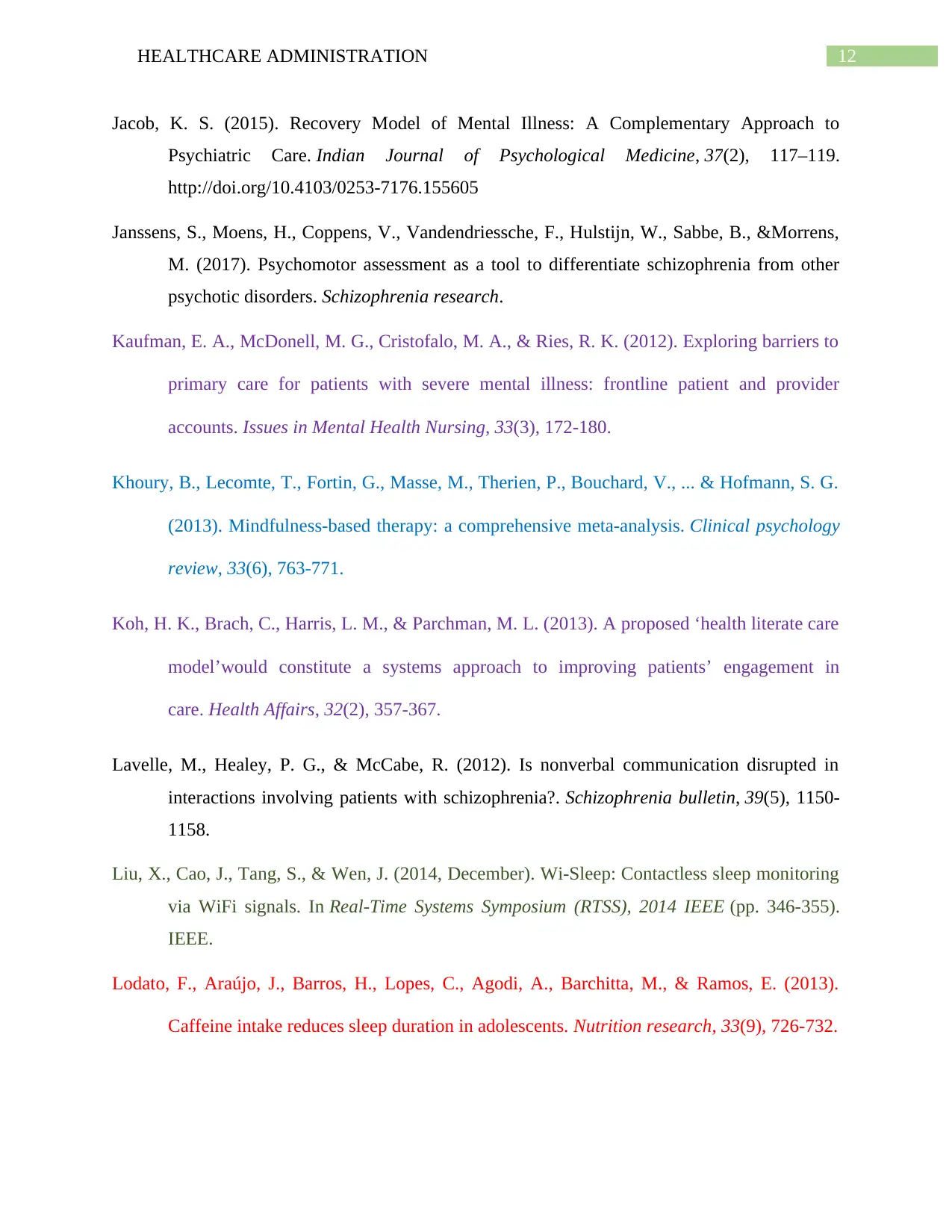
12HEALTHCARE ADMINISTRATION
Jacob, K. S. (2015). Recovery Model of Mental Illness: A Complementary Approach to
Psychiatric Care. Indian Journal of Psychological Medicine, 37(2), 117–119.
http://doi.org/10.4103/0253-7176.155605
Janssens, S., Moens, H., Coppens, V., Vandendriessche, F., Hulstijn, W., Sabbe, B., &Morrens,
M. (2017). Psychomotor assessment as a tool to differentiate schizophrenia from other
psychotic disorders. Schizophrenia research.
Kaufman, E. A., McDonell, M. G., Cristofalo, M. A., & Ries, R. K. (2012). Exploring barriers to
primary care for patients with severe mental illness: frontline patient and provider
accounts. Issues in Mental Health Nursing, 33(3), 172-180.
Khoury, B., Lecomte, T., Fortin, G., Masse, M., Therien, P., Bouchard, V., ... & Hofmann, S. G.
(2013). Mindfulness-based therapy: a comprehensive meta-analysis. Clinical psychology
review, 33(6), 763-771.
Koh, H. K., Brach, C., Harris, L. M., & Parchman, M. L. (2013). A proposed ‘health literate care
model’would constitute a systems approach to improving patients’ engagement in
care. Health Affairs, 32(2), 357-367.
Lavelle, M., Healey, P. G., & McCabe, R. (2012). Is nonverbal communication disrupted in
interactions involving patients with schizophrenia?. Schizophrenia bulletin, 39(5), 1150-
1158.
Liu, X., Cao, J., Tang, S., & Wen, J. (2014, December). Wi-Sleep: Contactless sleep monitoring
via WiFi signals. In Real-Time Systems Symposium (RTSS), 2014 IEEE (pp. 346-355).
IEEE.
Lodato, F., Araújo, J., Barros, H., Lopes, C., Agodi, A., Barchitta, M., & Ramos, E. (2013).
Caffeine intake reduces sleep duration in adolescents. Nutrition research, 33(9), 726-732.
Jacob, K. S. (2015). Recovery Model of Mental Illness: A Complementary Approach to
Psychiatric Care. Indian Journal of Psychological Medicine, 37(2), 117–119.
http://doi.org/10.4103/0253-7176.155605
Janssens, S., Moens, H., Coppens, V., Vandendriessche, F., Hulstijn, W., Sabbe, B., &Morrens,
M. (2017). Psychomotor assessment as a tool to differentiate schizophrenia from other
psychotic disorders. Schizophrenia research.
Kaufman, E. A., McDonell, M. G., Cristofalo, M. A., & Ries, R. K. (2012). Exploring barriers to
primary care for patients with severe mental illness: frontline patient and provider
accounts. Issues in Mental Health Nursing, 33(3), 172-180.
Khoury, B., Lecomte, T., Fortin, G., Masse, M., Therien, P., Bouchard, V., ... & Hofmann, S. G.
(2013). Mindfulness-based therapy: a comprehensive meta-analysis. Clinical psychology
review, 33(6), 763-771.
Koh, H. K., Brach, C., Harris, L. M., & Parchman, M. L. (2013). A proposed ‘health literate care
model’would constitute a systems approach to improving patients’ engagement in
care. Health Affairs, 32(2), 357-367.
Lavelle, M., Healey, P. G., & McCabe, R. (2012). Is nonverbal communication disrupted in
interactions involving patients with schizophrenia?. Schizophrenia bulletin, 39(5), 1150-
1158.
Liu, X., Cao, J., Tang, S., & Wen, J. (2014, December). Wi-Sleep: Contactless sleep monitoring
via WiFi signals. In Real-Time Systems Symposium (RTSS), 2014 IEEE (pp. 346-355).
IEEE.
Lodato, F., Araújo, J., Barros, H., Lopes, C., Agodi, A., Barchitta, M., & Ramos, E. (2013).
Caffeine intake reduces sleep duration in adolescents. Nutrition research, 33(9), 726-732.
Paraphrase This Document
Need a fresh take? Get an instant paraphrase of this document with our AI Paraphraser
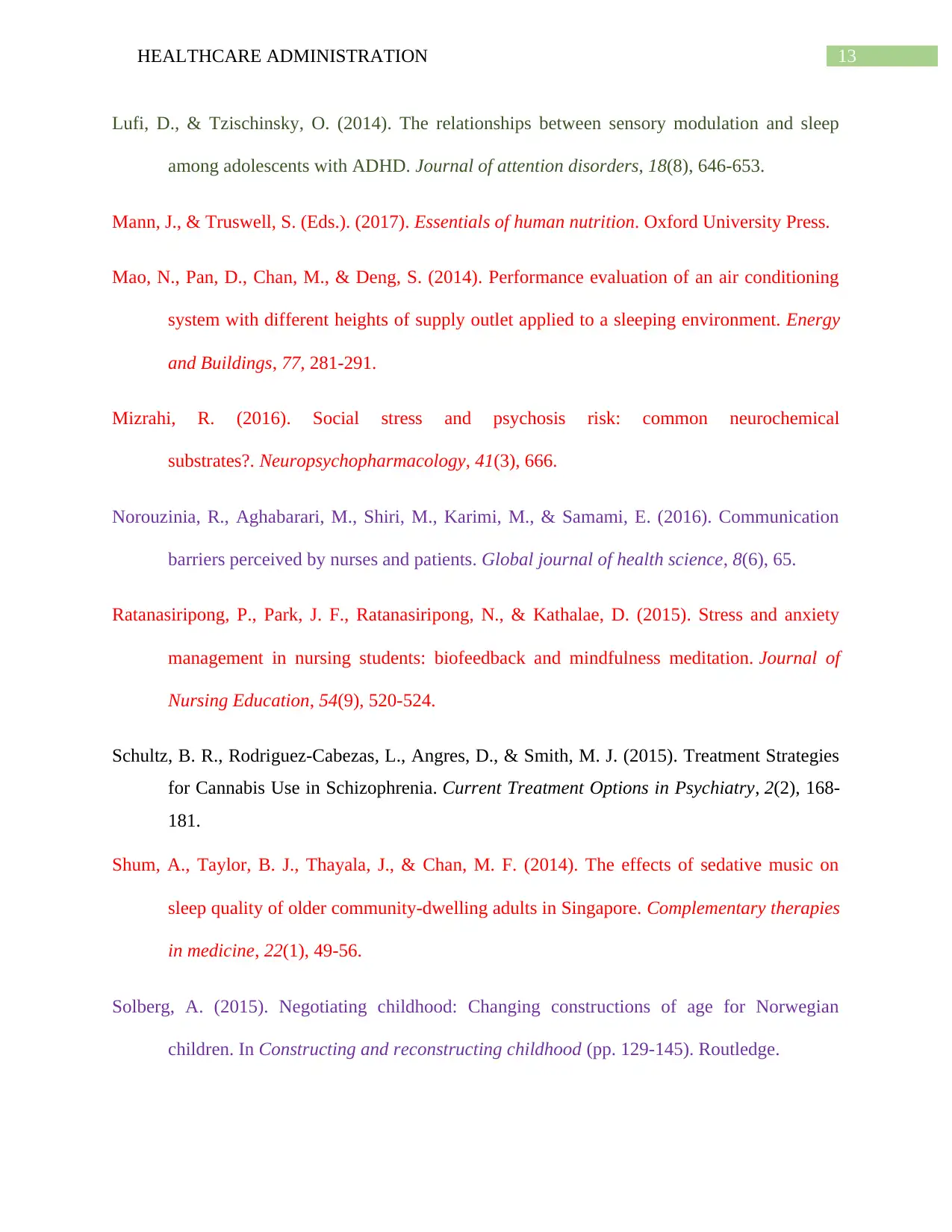
13HEALTHCARE ADMINISTRATION
Lufi, D., & Tzischinsky, O. (2014). The relationships between sensory modulation and sleep
among adolescents with ADHD. Journal of attention disorders, 18(8), 646-653.
Mann, J., & Truswell, S. (Eds.). (2017). Essentials of human nutrition. Oxford University Press.
Mao, N., Pan, D., Chan, M., & Deng, S. (2014). Performance evaluation of an air conditioning
system with different heights of supply outlet applied to a sleeping environment. Energy
and Buildings, 77, 281-291.
Mizrahi, R. (2016). Social stress and psychosis risk: common neurochemical
substrates?. Neuropsychopharmacology, 41(3), 666.
Norouzinia, R., Aghabarari, M., Shiri, M., Karimi, M., & Samami, E. (2016). Communication
barriers perceived by nurses and patients. Global journal of health science, 8(6), 65.
Ratanasiripong, P., Park, J. F., Ratanasiripong, N., & Kathalae, D. (2015). Stress and anxiety
management in nursing students: biofeedback and mindfulness meditation. Journal of
Nursing Education, 54(9), 520-524.
Schultz, B. R., Rodriguez-Cabezas, L., Angres, D., & Smith, M. J. (2015). Treatment Strategies
for Cannabis Use in Schizophrenia. Current Treatment Options in Psychiatry, 2(2), 168-
181.
Shum, A., Taylor, B. J., Thayala, J., & Chan, M. F. (2014). The effects of sedative music on
sleep quality of older community-dwelling adults in Singapore. Complementary therapies
in medicine, 22(1), 49-56.
Solberg, A. (2015). Negotiating childhood: Changing constructions of age for Norwegian
children. In Constructing and reconstructing childhood (pp. 129-145). Routledge.
Lufi, D., & Tzischinsky, O. (2014). The relationships between sensory modulation and sleep
among adolescents with ADHD. Journal of attention disorders, 18(8), 646-653.
Mann, J., & Truswell, S. (Eds.). (2017). Essentials of human nutrition. Oxford University Press.
Mao, N., Pan, D., Chan, M., & Deng, S. (2014). Performance evaluation of an air conditioning
system with different heights of supply outlet applied to a sleeping environment. Energy
and Buildings, 77, 281-291.
Mizrahi, R. (2016). Social stress and psychosis risk: common neurochemical
substrates?. Neuropsychopharmacology, 41(3), 666.
Norouzinia, R., Aghabarari, M., Shiri, M., Karimi, M., & Samami, E. (2016). Communication
barriers perceived by nurses and patients. Global journal of health science, 8(6), 65.
Ratanasiripong, P., Park, J. F., Ratanasiripong, N., & Kathalae, D. (2015). Stress and anxiety
management in nursing students: biofeedback and mindfulness meditation. Journal of
Nursing Education, 54(9), 520-524.
Schultz, B. R., Rodriguez-Cabezas, L., Angres, D., & Smith, M. J. (2015). Treatment Strategies
for Cannabis Use in Schizophrenia. Current Treatment Options in Psychiatry, 2(2), 168-
181.
Shum, A., Taylor, B. J., Thayala, J., & Chan, M. F. (2014). The effects of sedative music on
sleep quality of older community-dwelling adults in Singapore. Complementary therapies
in medicine, 22(1), 49-56.
Solberg, A. (2015). Negotiating childhood: Changing constructions of age for Norwegian
children. In Constructing and reconstructing childhood (pp. 129-145). Routledge.

14HEALTHCARE ADMINISTRATION
Taylor, S. P., Nicolle, C., & Maguire, M. (2013). Cross-cultural communication barriers in
health care. Nursing Standard (through 2013), 27(31), 35.
Tessaro, M., & Navarro-Peternella, F. M. (2015). Sleeping effects in the quality of life of women
with insomnia. Fisioterapia em Movimento, 28(4), 693-700.
Thompson, L., & McCabe, R. (2012). The effect of clinician-patient alliance and communication
on treatment adherence in mental health care: a systematic review. BMC
psychiatry, 12(1), 87.
Thomson, C., Wilson, R., Collerton, D., Freeston, M., & Dudley, R. (2017). Cognitive
behavioural therapy for visual hallucinations: an investigation using a single-case
experimental design. The Cognitive Behaviour Therapist, 10.
Vancampfort, D., Probst, M., HelvikSkjaerven, L., Catalán-Matamoros, D., Lundvik-Gyllensten,
A., Gómez-Conesa, A., ...& De Hert, M. (2012). Systematic review of the benefits of
physical therapy within a multidisciplinary care approach for people with
schizophrenia. Physical therapy, 92(1), 11-23.
Waters, F., Collerton, D., Ffytche, D. H., Jardri, R., Pins, D., Dudley, R., ... & Larøi, F. (2014).
Visual hallucinations in the psychosis spectrum and comparative information from
neurodegenerative disorders and eye disease. Schizophrenia bulletin, 40(Suppl_4), S233-
S245.
Xie, H. (2013). Strengths-Based Approach for Mental Health Recovery. Iranian Journal of
Psychiatry and Behavioral Sciences, 7(2),
Yehuda, R., Hoge, C. W., McFarlane, A. C., Vermetten, E., Lanius, R. A., Nievergelt, C. M., ...
& Hyman, S. E. (2015). Post-traumatic stress disorder. Nature Reviews Disease
Primers, 1, 15057.
Taylor, S. P., Nicolle, C., & Maguire, M. (2013). Cross-cultural communication barriers in
health care. Nursing Standard (through 2013), 27(31), 35.
Tessaro, M., & Navarro-Peternella, F. M. (2015). Sleeping effects in the quality of life of women
with insomnia. Fisioterapia em Movimento, 28(4), 693-700.
Thompson, L., & McCabe, R. (2012). The effect of clinician-patient alliance and communication
on treatment adherence in mental health care: a systematic review. BMC
psychiatry, 12(1), 87.
Thomson, C., Wilson, R., Collerton, D., Freeston, M., & Dudley, R. (2017). Cognitive
behavioural therapy for visual hallucinations: an investigation using a single-case
experimental design. The Cognitive Behaviour Therapist, 10.
Vancampfort, D., Probst, M., HelvikSkjaerven, L., Catalán-Matamoros, D., Lundvik-Gyllensten,
A., Gómez-Conesa, A., ...& De Hert, M. (2012). Systematic review of the benefits of
physical therapy within a multidisciplinary care approach for people with
schizophrenia. Physical therapy, 92(1), 11-23.
Waters, F., Collerton, D., Ffytche, D. H., Jardri, R., Pins, D., Dudley, R., ... & Larøi, F. (2014).
Visual hallucinations in the psychosis spectrum and comparative information from
neurodegenerative disorders and eye disease. Schizophrenia bulletin, 40(Suppl_4), S233-
S245.
Xie, H. (2013). Strengths-Based Approach for Mental Health Recovery. Iranian Journal of
Psychiatry and Behavioral Sciences, 7(2),
Yehuda, R., Hoge, C. W., McFarlane, A. C., Vermetten, E., Lanius, R. A., Nievergelt, C. M., ...
& Hyman, S. E. (2015). Post-traumatic stress disorder. Nature Reviews Disease
Primers, 1, 15057.

15HEALTHCARE ADMINISTRATION
Secure Best Marks with AI Grader
Need help grading? Try our AI Grader for instant feedback on your assignments.

16HEALTHCARE ADMINISTRATION
1 out of 17
Related Documents
Your All-in-One AI-Powered Toolkit for Academic Success.
+13062052269
info@desklib.com
Available 24*7 on WhatsApp / Email
![[object Object]](/_next/static/media/star-bottom.7253800d.svg)
Unlock your academic potential
© 2024 | Zucol Services PVT LTD | All rights reserved.





